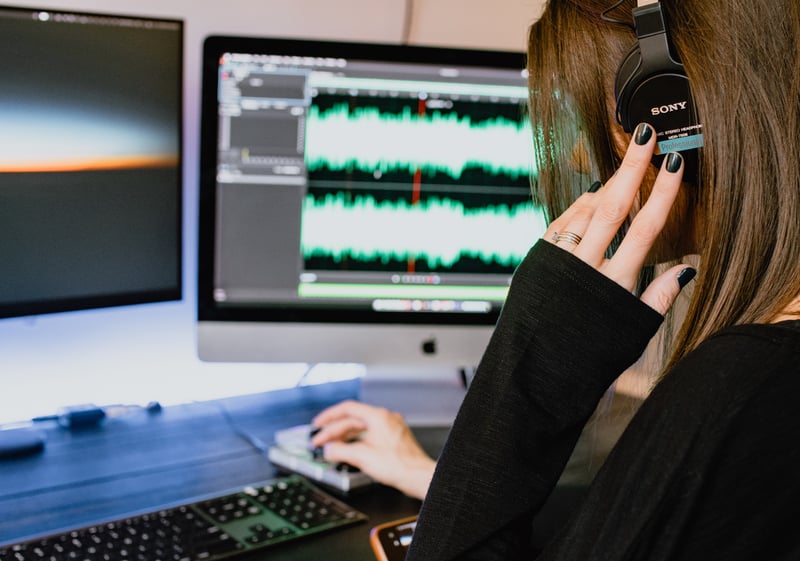Get started on your sound design journey with helpful strategies and resources.
When it comes to learning a new skill, the sheer amount of information on the internet can be both a blessing and a curse. A simple search query like “how to learn sound design” brings up a plethora of tutorial videos, blogs, listicles, and educational courses – all with varying levels of quality – making it difficult to find the information you want. There are guides for creating sound effects, deep dives into game audio programming, synth tips for music production, and much more. Whichever aspect of sound design you’re interested in, you can learn all about it online – if you have the patience.
To demystify the art of sound design and help get you started on your journey, we’ve put together this guide with helpful strategies and resources from beginner to intermediate levels.
Learning the Basics
If you’re brand-new to sound design, your first steps should be to get familiar with what exactly it is, then decide what kind of sound design you want to pursue. In broad terms, sound design is defined as the creative application of sound to help tell a story, convey emotion, or communicate information. For a more detailed intro to the world of sound design, see our 101 Series articles.
Sound design is a broad field that includes sound work for film and TV, game development, app design, music production, live sound, theater, and more. If you already know which of these interests you, seek out resources specific to that profession. Or, if you’re new to all of the above and not sure which to focus on, take your time and learn a little bit about each of those areas. You might find that you have a knack for making cartoon sound effects, a passion for accessible UI design, or something else entirely!
After getting familiar with the basics of sound design and choosing one or more focus areas, the next best step is to simply start experimenting. No matter what tools you have available, you can start learning sound design at any time – all you have to do is imagine a sound, then open your audio software and start trying to create it. Depending on what you’re trying to do, you can start by combining and manipulating free sound effects, making your own recordings to process, or creating completely original sounds with synthesizers and effects.
While you learn and experiment, it’s helpful to watch lots of media while keeping your ears open for interesting sound moments to analyze. The more movies, games, and other media you absorb, the more you’ll internalize the art of sound design, giving you reference points to evaluate your own work. When you hear something you like, ask yourself why it was effective, how it might have been done, and how you would have done it. It’s also helpful to hear what experts have to say, such as this sound design masterclass with Richard King.
Sound Design Resources
Once you’ve gotten familiar with the basics of sound design and chosen your area(s) of interest, there’s a wide world of sound design resources to explore and learn from. If you learn best by reading, be sure to check out our interviews with award-winning sound designers to get the inside scoop on the making of the latest movies and shows.
If you prefer to learn by watching videos, YouTube is a great source of educational content spanning everything from sci-fi sound effects tutorials to sound design breakdowns from famous films and even tips for making beats with sound effects. If podcasts are more your style, check out Twenty Thousand Hertz for deep-dive explorations of iconic sounds or Tonebenders for interviews with the sound teams behind some of your favorite movies, shows, and games. Or, if you’re into game audio and prefer interactive learning, middleware engines like Wwise and FMOD have self-guided courses complete with practice projects that you can add your own sounds to.
Finally, if you’re the type of person who benefits from a structured learning environment, you might want to consider attending a school like SCAD where you can learn directly from seasoned professionals, practice hands-on with industry-standard tools, and collaborate with peers in other creative programs like Film and Television, Animation, and Immersive Reality. If you want to work with large teams on big-budget projects, the experience and connections you’ll gain at a media school like SCAD will be invaluable.
"No matter what tools you have available, you can start learning sound design at any time – all you have to do is imagine a sound, then open your audio software and start trying to create it."
Working on a real project is the best way to advance your skills.
Getting Real-World Experience
The resources above can be valuable learning tools, but at some point, you’ll need to work on a real project in order to get better. To test your skills in a low-stakes way, try doing sound redesigns as practice: find a scene from a movie, a trailer video, or a gameplay recording, then strip out the audio and rebuild the scene by creating your own sounds. Redesign projects can be a great way to start building a demo reel – just remember to make it clear that you did not work on the original project.
When you feel confident enough to offer your services to a real project, start by looking for collaborators with the same level of experience as you. When you reach out to beginning filmmakers, game developers, or other creatives, be careful not to oversell your abilities. Be clear that you’re just starting your sound design career, but don’t undervalue your work, either. With a professional attitude and some luck, you might find collaborators early on who you can keep working with throughout your career.
If you’re having trouble finding paid work, volunteering is a great way to get experience and form connections with other creators. First, see if your city or state offers any filmmaking grants – if they do, you might be able to volunteer your services in lieu of a monetary donation. Even if there isn’t an opportunity like that in your area, you can volunteer to help local organizations by editing video content and podcasts.
Continuing Your Sound Design Education
As you practice and improve at the craft of sound design, a learning mindset will help you keep advancing your skills and knowledge. Any project can teach you something, whether it’s a new processing technique, a positive comment from a client, or something you know could have done better. Take note of these learning opportunities, and when you have a lull in between projects, keep practicing on your own, seeking out resources, and sharing your knowledge with others.
Dante Fumo is a Midwest-based sound designer, editor, and mixer specializing in independent film and Dolby Atmos mixing. In his free time, Dante composes electronic music and publishes Harmonic Content, a zine about sound.














